The Battle of Salado
The Mexican Army Invades Texas in the Fall of 1842
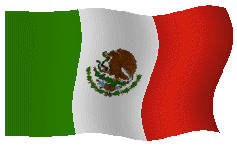 On the morning of September 11, 1842, a Mexican Army captured San Antonio, Texas, in a lightning fast move. General Adrian Woll was in command. He was a Belgian mercenary but was born in France. His name was pronounced "Gual" in the native French. He caught the Texans there completely by surprise. He commanded a force of 1450 infantry, cavalry and artillery troops and captured the town without a shot being fired in it's defense. He decided to wake up the surprised citizens of San Antonio that morning with the sounds of his "noise only" cannon fire.
"However, news of the invasion spread rapidly to the former DeWitt Colony settlements of Seguin, Gonzales and the Lavaca River as well as into the settlements on the Colorado and Brazos Rivers via couriers who had escaped imprisonment.
On the morning of September 11, 1842, a Mexican Army captured San Antonio, Texas, in a lightning fast move. General Adrian Woll was in command. He was a Belgian mercenary but was born in France. His name was pronounced "Gual" in the native French. He caught the Texans there completely by surprise. He commanded a force of 1450 infantry, cavalry and artillery troops and captured the town without a shot being fired in it's defense. He decided to wake up the surprised citizens of San Antonio that morning with the sounds of his "noise only" cannon fire.
"However, news of the invasion spread rapidly to the former DeWitt Colony settlements of Seguin, Gonzales and the Lavaca River as well as into the settlements on the Colorado and Brazos Rivers via couriers who had escaped imprisonment.
In San Antonio the District Court of the Republic of Texas had been in session under Judge Anderson Hutchison since the first of September with attendance by many area officials and lawyers from as far away as Gonzales. The advocates had no choice but to surrender to General Woll’s forces under conditions that they would be treated as gentleman. After five days, about 55 prisoners were told that they would have to march to the Rio Grande where they would be handed over into the custody of his superior, General Reyes and likely be set free."
Quoted from Adam Zumwalt Jr., Captain "Black" Adam Zumwalt in the Battle of Salado- Dawson Massacre
Houston was emotionally aggravated by this news. He issued mobilization orders to the Texas militia to expel the invaders and pursue them into Mexico if necessary so
"that they should receive that chastisement which the injuries inflicted upon us imperiously demand."
Houston's attitude appeared to be: Santa Anna can capture San Antonio but let's see if he can hold it.
Quoted from DeBruhl, Sword of San Jacinto, op.cit., page 298
The Mexicans held San Antonio for nine days. They marched off their prisoners to Mexico and waited to see what the Texans would do next. Santa Anna wanted to make sure that the messages he was sending to Texas was crystal clear. Did these actions prevent this? No. Texas still joined with the United States, and during the Mexican War with the United States, Mexico lost a great deal more land including what is now the states of Arizona, New Mexico, Nevada, and California.
 Texas president Houston ordered Colonel Mathew Caldwell of the Texas Army at Gonzales, Texas, to gather together the Texas minutemen and militia to attack Gen. Woll at San Antonio. Caldwell gathered a militia of 225 men at the Cibolo River on the San Antonio Road above Seguin and marched toward San Antonio. Some of these troops included former prisoners involved in the unsuccessful Santa Fe expedition including Colonel Mathew Caldwell. On September 17, his troops made camp about 6 miles east of San Antonio below present New Braunfels at Salado Creek and planned their attack on the Mexicans.
Texas president Houston ordered Colonel Mathew Caldwell of the Texas Army at Gonzales, Texas, to gather together the Texas minutemen and militia to attack Gen. Woll at San Antonio. Caldwell gathered a militia of 225 men at the Cibolo River on the San Antonio Road above Seguin and marched toward San Antonio. Some of these troops included former prisoners involved in the unsuccessful Santa Fe expedition including Colonel Mathew Caldwell. On September 17, his troops made camp about 6 miles east of San Antonio below present New Braunfels at Salado Creek and planned their attack on the Mexicans.
On September 18, Caldwell sent a force of Texas Rangers headed by Captain John C. (Jack) Hays to draw the Mexicans toward the battlefield he had chosen. Their military mission was to lure the greater Mexican force toward the force of 202 Texans. The Texans had the battlefield chosen to their advantage.
"From a ridge 300 to 400 yards from the Alamo, Hays men waved, shouted and challenged the enemy to come out of the Alamo onto the field, as if they were preparing for battle. The actions resulted in a charge of over 400 Mexican cavalrymen out of the Alamo, which turned to a hot pursuit when Capt. Hays and the company turned around and appeared to be running away toward the Salado River. Some distance out, the horse of Captain Augustus H. Jones of Gonzales, a close personal friend of Captain Hays, began to fall behind in relation to the others in the main force. Captain Hays put the entire company just behind Captain Jones with his slower mount leading the way. This contingent led the Mexican force across the Salado River right to Capt. Caldwell's waiting men, hidden in the sunken river bed of brushy bottom land."
Quoted from Adam Zumwalt Jr., Captain "Black" Adam Zumwalt in the Battle of Salado- Dawson Massacre
The Mexican cavalry charged Caldwell's position but many of their soldiers were shot off of their horses. They dismounted and formed a skirmishing line, firing for 3 hours. They sent word to General Woll who marched out of San Antonio with an estimated 850 Mexican soldiers and 2 cannons to attack the Texans.
 The Mexican Army attacked across open ground in front of Caldwell's men. They were cut to pieces. The front lines of the Mexican infantry were forced to fall back behind their cannons for cover, out of rifle range. They made several smaller charges that were repulsed with heavy casualties.
The Mexican Army attacked across open ground in front of Caldwell's men. They were cut to pieces. The front lines of the Mexican infantry were forced to fall back behind their cannons for cover, out of rifle range. They made several smaller charges that were repulsed with heavy casualties.
"Col. Caldwell and the Texans- in good concealment in the Salado bottom- resisted the Mexican attack, killed 60 Mexicans and wounded many more, with only one Texan killed and 9 wounded."
Quoted from Gen. Thomas Green's Journal of the Texian Expedition Against Mier.
In this battle "Caldwell was doing splendidly, because he knew how to fight both Mexicans and Indians and knew better than to give either an even break. The Mexican cavalry could not ride into his timbers and no Mexican infantry force of only three-to-one could assault Texas rifles firing from cover."
Quoted from Fehrenbach, ibid, page 478
But just as the frontal fight ceased between Caldwell and the Mexicans another battle started. Capt. Nicholas Mosby Dawson showed up with fifty-three Texas minutemen who attacked Woll's rear guard troops. There was quite a battle and several Mexican soldiers were killed and wounded. Dawson was trying to join Caldwell but was at a tactical disadvantage and out-numbered. Him and his men were soon placed on the defensive and defeated.
Texas General Green stated,
"Gen Woll, sorely disappointed in driving the Texian wolves from the bush, was about retreating when he was informed a company of Texians was advancing upon his rear, some two miles distant. This company proved to be the gallant and lamented Captain Dawson and his 53 men, mostly from Fayette Co., who had determined upon succouring Caldwell; and it proved a favorable opportunity for General Woll to withdraw from Caldwell without the appearance of flight; consequently, he retreated to some distance and dispatched a large portion of his force to attack Dawson."
Quoted from Gen. Thomas Green's Journal of the Texian Expedition Against Mier.
At sundown, Gen. Woll carried his dead and wounded off of the 2 battlefields. His army returned to San Antonio for the night and then retreated over the Rio Grande River back into Mexico. General Woll had delivered Santa Anna's messages to Texas bureaucrats
written in blood.
The Texas Dawson Expedition 
It is my great delight to share with you the complete story of the Dawson Expedition as I understand it. I place this story here because Thomas M. Rice was killed in this battle.
Dictator Santa Anna of Mexico received a letter dated March 21, 1842 from Sam Houston of Texas, which said: "Every citizen of Texas was born a free man, and he would be a recreant to the principles imbibed from his ancestry if he would not freely peril his life in defense of his home, his liberty and his country."
"Ever ready to fight, Fayette County was not slow in answering John Hays' urgent call for volunteers to San Antonio. Hays' runners had left San Antonio on Sunday, Sept. 11. By the following Friday, Capt. Nicholas M. Dawson had assembled the nucleus of his band under the historic oak at LaGrange. The band numbered 15 or more. Leaving at once, these men crossed the Colorado on the ferry, near the present old bridge."
"Small groups of volunteers joined Dawson's company on the horseback march to San Antonio, augmenting their number to 53. "They crossed the Colorado River on a ferry run by a Mr. McAhron where they were joined by John Bradley and Francis E. Brookfield. Mrs. Samuel Augustus Maverick, wife of Samuel Maverick, who had been captured during the takeover of San Antonio on 11 September was at the home of Bradley who was her uncle. The contingent moved along the Old Seguin Road which stretched from La Grange through Cedar, O'Quinn, Black Jack Springs, Muldoon, Colony, Elm Grove and Waelder on the way to Seguin toward San Antonio. Between O'Quinn and Black Jack Springs, they were joined by 70 year old David Berry and son-in-law Harvey Hall. Capt. Patrick Lewis and preacher's sons Allen H. Morrell and John Dancer joined them near Black Jack Springs. A group of men from Wood's Prairie near West Point joined at the Ivy School House. They were Joseph C. Robinson, Zed Barkley and sons Robert and Richard Barkley, 69
year old Zadock Woods and sons Norman B. and Henry Gonsalvo, William James Trimble and brother Edward, Norman Miles Wells (nephew of Zadock Woods' wife) and John Wesley Pendleton (nephew of the younger Woods boys). Near Waelder, they were joined by Milvern Harrell (brother-in-law to Pendleton) and Richard Slack."
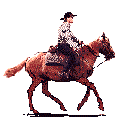 "Passing Waelder, they were overtaken by two current Lavaca County residents, John Cummings and W.D. Patterson. Residents from the area, now DeWitt County, Thomas J. Butler, Elijah Garey, Thomas Rice and William Savage caught up with the group near the same area. On down the Seguin Road, the Negro slave of Samuel A. Maverick, Joe Griffin, caught up with the group. He was heavily armed and carrying a ransom sent by Mrs. Maverick for release of her husband. Somewhere near Nash's Creek about 15 miles west of Gonzales, Alsey Miller joined the group from the company of Capt. Jesse Billingsley which was still forming for the trip to San Antonio. Capt. Dawson could not be persuaded to wait for Capt. Billingsley who suggested that they march to San Antonio together. A Mr. Adams, Charles Fields, Thompson D. James, Asa Jones, John Jones, William Linn and John McCrady joined the Dawson group somewhere on the journey. At camp near Nash's Creek, Capt. Dawson was elected Captain and Dickerson Lieutenant."
"Passing Waelder, they were overtaken by two current Lavaca County residents, John Cummings and W.D. Patterson. Residents from the area, now DeWitt County, Thomas J. Butler, Elijah Garey, Thomas Rice and William Savage caught up with the group near the same area. On down the Seguin Road, the Negro slave of Samuel A. Maverick, Joe Griffin, caught up with the group. He was heavily armed and carrying a ransom sent by Mrs. Maverick for release of her husband. Somewhere near Nash's Creek about 15 miles west of Gonzales, Alsey Miller joined the group from the company of Capt. Jesse Billingsley which was still forming for the trip to San Antonio. Capt. Dawson could not be persuaded to wait for Capt. Billingsley who suggested that they march to San Antonio together. A Mr. Adams, Charles Fields, Thompson D. James, Asa Jones, John Jones, William Linn and John McCrady joined the Dawson group somewhere on the journey. At camp near Nash's Creek, Capt. Dawson was elected Captain and Dickerson Lieutenant."
"A courier, John Wilson, from Capt. Caldwell urging reinforcements and describing his location apparently stimulated Capt. Dawson to embark essentially on a forced march. All day Friday and part of the night was spent lessening the distance to the beleagured Alamo City which resulted in reaching Seguin at daylight on 17 Sept. about 45 miles from Salado. Breaking camp early on the morning of Sept. 17, Dawson and his men pressed forward on a march that demanded the last ounce of energy from fatigued horseflesh. With everything sacrificed to speed, there seems to have been no camp made on Saturday night. Apparently no halt was made until the Cibolo River was reached in the early morning hours of the fateful Sunday, Sept. 18, 1842. Both men and horses arrived exhausted."
Quoted from Adam Zumwalt Jr., Captain "Black" Adam Zumwalt in the Battle of Salado- Dawson Massacre
Scouts were sent forward from here in an effort to locate Caldwell and his company, but they apparently found Mexicans instead. Alsey S. Miller- a scout by virtue of having the only fresh horse in the band and being acquainted with the territory- was sent forward to contact Caldwell. Miller never reached him. The Battle of Salado was being fought, and Miller approached only close enough to ascertain this fact. Miller hurried back to Dawson's camp. On the way, he was charged by three Mexican cavalrymen and in the fight which ensued Miller killed one of them and eluded the others, making his way safely back to Dawson.
Another scout reported that another group of cavalry appeared to be friendly Texan forces but these were (in totality) two Mexican groups of cavalry converging on Dawson from two different directions cutting off any retreat that he might have wanted. Dawson was surrounded by a tactical pincer movement between the two groups of Mexican cavalry, one group on his left and and the other on his right.
"Dawson now held a consultation with his men. Should they attack and try to join Caldwell, or should they retreat and wait to join the Texas companies coming in from the east for reinforcements. Zadock Woods, oldest man of the band, voiced the prevailing sentiments: "We have marched a long way to meet the Mexicans, and I do not intend to return without meeting them. I had rather die than retreat." So Dawson gave the order to attack. Both Texan forces were out of view of each other. Capt. Caldwell's men were completely unaware of the Dawson force and action just 1 1/2 miles from the main battlefield."
Quoted from Weyand and Wade's 1936 book, An Early History of Fayette County.
The next events are chronicled in Gen. Thomas Green's Journal of the Texian Expedition Against Mier:
"As Dawson and his men traveled across the prairie in open country, 400 Mexican cavalry appeared. Dawson decided to dismount and fight them on foot. He selected his position in a musquet thicket favorable for his rifle-shooting, and where he could have whipped a much superior force of Mexicans with small arms; but, to his surprise, after the first fire from his party, at which several Mexicans fell, their whole force withdrew to a distance beyond the reach of the rifle, and opened upon the Texians with a fieldpiece (cannon)."
The Mexican's loaded their cannon with lead rifle bullets instead of a cannon ball. This is called grape shot or cannister. When the cannon was fired it acted much like a big shotgun spraying flying lead in all directions, killing Texas men and horses.
Green fails to take note of the fact that Captain Nicholas Dawson was offered terms of surrender by Colonel Carasco before Woll's troops opened fire with their cannon, but Dawson rejected them.
The Texians were entirely exposed to the fire from the enemy's cannon, being in a smooth prairie, only partially protected by small musquet (mesquite) timbers, not sufficiently large to shield them from the cannon shot.
...with many of their horses either killed, wounded, or otherwise broken loose from their charge, they found no means left of retreating. Dawson's men and horses rapidly fell from the fire of this deadly gun. Documents- including "Public Debt Papers" (No. 3124)- indicate Thomas Rice's horse was also killed.
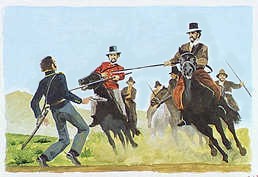 Captain Dawson was in a desperate way. He had approximately 26 men killed (half of his outfit), his means of escape was cut off, and he had no help coming from any quarter. Since his situation was hopeless, he decided to surrender. For an enemy leader to fall into Mexican hands meant almost certain death.
"Dawson sent out a white flag, but it was fired on," says the Yoakum account. A short time later Dawson emerged from the thicket with a blanket on his rifle in an attempt to call a cease-fire, but in the confusion some of his men took no notice and continued firing." In the fog of war, both sides continued to fire and Dawson was killed. The battle was over after a little more than one hour. Then a cavalry charge was made by the enemy into the grove against the Texians.
Captain Dawson was in a desperate way. He had approximately 26 men killed (half of his outfit), his means of escape was cut off, and he had no help coming from any quarter. Since his situation was hopeless, he decided to surrender. For an enemy leader to fall into Mexican hands meant almost certain death.
"Dawson sent out a white flag, but it was fired on," says the Yoakum account. A short time later Dawson emerged from the thicket with a blanket on his rifle in an attempt to call a cease-fire, but in the confusion some of his men took no notice and continued firing." In the fog of war, both sides continued to fire and Dawson was killed. The battle was over after a little more than one hour. Then a cavalry charge was made by the enemy into the grove against the Texians.
Quoted from Haynes, Soldiers of Misfortune, pages 21-22. http://www.smu.edu/swcenter/tjgreen/tjg_258.htm
Texas General Green gave this account: "Here followed a scene as disgraceful to the enemy as it was revolting to civilized man. After the Texians had surrendered up their arms, an indiscriminate slaughter took place; and, before any stop was put to it by the Mexican officers..." Captain Dawson and other Texans were massacred in a battle sometimes referred to as the Dawson Massacre. Thirty-two of Dawson's men were killed, two escaped, fifteen surrendered and the remainder were cut down after they had surrendered. Among those who escaped was Captain Wood, who, in the act of delivering up his arms, received a cut from a sword. He seized a lance in the hands of one of the enemy, killed the lancer, mounted his horse and escaped. His father, Zadoc Wood, aged 80 years, was killed. His brother Normon was badly wounded and died afterwards, while a prisoner, from his wounds. The other escaped one was A.S. Miller."
Quoted from The Mier Expedition by George Lord http://www.tamu.edu/ccbn/dewitt/mierlord.htm
 Thomas Rice killed in the Texas Dawson Expedition
Thomas Rice killed in the Texas Dawson Expedition

According to Wade's account, "Out of a group of 53 men, 35 were left dead on the ground, three escaped, and 15 were taken prisoner." Thomas Rice was among the 35 dead.
"As an officer under General Woll in the recent Mexican campaign against San Antonio, Colonel Carasco had displayed an eagerness to avoid bloodshed. When Woll's troops attacked the town on the morning of September 11, Carasco convinced the Anglo residents of Bexar to lay down their arms, impressing upon them the hopelessness of their situation. One week later, Mexican troops under Carasco engaged Dawson's company as it advanced to join the Texans at Salado Creek, but again the Mexican colonel moved to end the carnage once the defeat of Dawson's men was assured. According to Z. N. Morrell, whose son was among the Dawson survivors, Carasco drew his sword and drove his men away, thereby putting a stop to the slaughter."
Quoted from Morrell, Flowers and Fruits from the Wilderness, page 174. http://www.smu.edu/swcenter/tjgreen/tjg_264.htm
A second contigent of Texans, numbering about 100 men under James S. Mayfield, reached the scene of the conflict the evening of the 18th, having almost overtaken Dawson. Scouts advised Mayfield of Dawson's plight; the force advanced to the edge of the timber and watched Dawson and his men fight to the death. Mayfield thought it folly to attack the Mexicans, who so outnumbered them and had artillery, so his detachment failed to go to the rescue of Dawson; they camped in the timber until night and then joined Caldwell the next day.
About sundown, Gen. Woll re-assembled his entire war machine- employing about 60 carts to bear away most of his 200 wounded and some of his dead- and made a triumphal entry into San Antonio; from there, he returned to Mexico.
When Col. Caldwell's men arrived the next day, a horrible sight confronted them. Dawson's dead had been stripped and mutilated. Meanwhile, the prisoners were being marched to Mexico where they faced death.
The obituary of the Dawson Expedition is found in the Houston newspaper, Telegraph and Texas Register: "The details of the fate of the unfortunate company from La Grange are distressing in the extreme; there is consolation, however, in the recollection that they fought nobly to the last and died like the immortal heroes of the Alamo, bidding defiance to the foe. Their names shall live while the name of Texas endures, illumined with a halo of glory."
Note: there is a town named Salado, which is north of Georgetown, Texas on I-35. But that town has nothing to do with the Battle of Salado. The Battle of of Salado occurred on the Salado Creek which runs northwest to southeast through Bexar County and eventually joins the San Antonio River south of San Antonio. Now Salado Creek is actually in San Antonio, however, when they were doing all that fighting, it was north and east of the city.
The Burial Of Thomas Rice
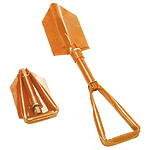
The body of Thomas Rice was buried on Monday, September 19, 1842, in the grove where he had fallen. Wade reports: "The bodies of Dawson and his men were buried that day on the prairie of the grove."
It was a delegation of men from Fayette County who brought the remains of Capt. Dawson and his men from from their burial site near Salado Creek to the La Grange Court House 6 years later. On the sixth anniversary of the Dawson Massacre in 1848- in the presence of Sam Houston and a great concourse of dignitaries and citizens from all over Texas- the remains of these patriots and the remains of the men killed in the failed Mier Expedition were given a military burial (were reinterred in a common tomb) in a cement vault high on Monument Hill, a site selected for its grandeur, one mile south of La Grange, Texas.

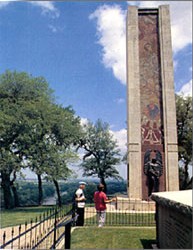 During the 1936 Texas Centennial Year, $10,000 was provided for the erection of a suitable memorial to those Texas martyrs in the cause of liberty. An imposing granite vault was erected to enclose the original tomb which had deteriorated. The Dawson marker was unveiled near the Salado Battlefield with appropriate ceremonies on the 93rd anniversary of the battle, Sept. 18, 1935." The grave site is now part of the Kreische Brewery State Historic Site.
During the 1936 Texas Centennial Year, $10,000 was provided for the erection of a suitable memorial to those Texas martyrs in the cause of liberty. An imposing granite vault was erected to enclose the original tomb which had deteriorated. The Dawson marker was unveiled near the Salado Battlefield with appropriate ceremonies on the 93rd anniversary of the battle, Sept. 18, 1935." The grave site is now part of the Kreische Brewery State Historic Site.
"The remains of the thirty six men who fell with Captain Nicholas M. Dawson and sixteen of the seventeen men who drew black beans at the Hacienda Salado in Mexico, March 25, 1843, while on the Mier Expedition and were shot by their Mexican Captors were exhumed and on September 18, 1848 placed in a single vault on a hill overlooking the Colorado River and the city of La Grange, Texas. Their place of interment is now shown as Monument Hill. A new tomb erected by the citizens of Fayette County was unveiled over the grave of these martyrs, September 18, 1933, with elaborate ceremonies."
Quoted from http://www.sanjacinto-museum.org/Herzstein_Library/Veteran_Biographies/Browse_Biographies/biographies/default.asp?action=bio&id=3556
Dawson County, Texas, was named in honor of Captain Nicholas Mosby Dawson, who also was a Texas Ranger leader.
"At the Fayette County Courthouse (c. 1891)- approaching the main entrance to the building- is an obelisk in memory of the Fayette County men who were killed with Captain Nicholas Mosby Dawson at Salado Creek- just outside of San Antonio in 1842."
Quoted from http://www.texasescapes.com/TexasCourthouses/FayetteCounty/FayetteCoCourthouseExterior2Obelisk.htm
 Some More Information on the Dawson Expedition
Some More Information on the Dawson Expedition
"The exact details of subsequent events vary with the reporter, but most historians agree that Dawson raised the white flag of surrender. Either the men were not unified in the surrender decision, in panic fired on Mexican troops handling the surrender at point blank range or some Mexican troops failed to cease fire or a combination of both. They were charged by the Mexican force and shot down systematically until Col. Carrasco and other Mexican officers regained control of their men. Of the force of 54, 36 were killed, 3 escaped (Thomas D. James, Alsey S. Miller and Gonsalvo Woods) and 15 were taken prisoner.
John McGrady and W.D. Patterson died after escape trying to cross the Rio Grande; John Higgerson was killed escaping from El Rancho Salado on the way to Perote Prison; William Coltrin, William James Trimble, Norman B. Woods died in Perote Prison near Mexico City; Richard A. Barkley, David Smith Kornegay, John Bradley, Nathaniel W. Faison, Milvern Harrell, Edward T. Manton, Allen H. Morrell, Joseph Robinson and Joseph Shaw were released from Perote Prison in 1843-1844.
The next morning the dead were found by members of Capt. Caldwell’s force lying on the field, stripped naked of all clothes and belongings, many mutilated and decapitated beyond recognition. On the morning of 20 Sep, Capt. Caldwell learned of Gen. Woll’s retreat toward the Rio Grande River and began pursuit along with Capt. Jack Hays company and joined along the way by numerous groups of volunteers from diverse settlements. Capt. Zumwalt’s company from the Lavaca River was ordered to attend wounded and return them to San Antonio. The pursuing forces skirmished with the rear guard of the Mexican force. On the Hondo River, learning that Gen. Woll’s army had crossed the Rio Grande the Texan force by majority vote in favor of Capt. Caldwell's opinion, returned to San Antonio without crossing the border. At San Antonio, where combined volunteers of over 1200 reassembled after the Mexican invasions of the past two years, Col. Edward Burleson made a speech denouncing the invasions and announced plans that led to the ill-fated Somerville and Mier Expeditions aimed at invasion of Mexico in late 1842."
Quoted from Adam Zumwalt Jr., Captain "Black" Adam Zumwalt in the Battle of Salado- Dawson Massacre

Sad News from Texas
Jemima Rice, Thomas' mother, must have had a strong constitution, for she was acquainted with much grief in her family. In the 1820's, she lost her mother and her oldest daughter, Mrs. Luceba (Rice) Stacey, who died in childbirth at age 29 on Feb. 28, 1827. In the 1840's, she lost her husband and her only son, Thomas. Jemima never remarried and is buried alongside her husband at Rainbow Cemetery (near where their Ohio home once stood).
The following statement was recorded in the Witham family records in Ohio: "Thomas Rice killed in the Texas Army." The Withams are related to the Rices because Zilpha Rice, sister of Thomas Rice, married Elisha Witham.

In the late 1970's I went to the big library in Columbus, Ohio, to read the newspapers from that time period. I was looking for genealogical and historical information. Here is what I found in relation to the Dawson Expedition:
These are two early accounts from newspapers regarding the Dawson Expedition. The account from the Marietta, Ohio, newspaper is the one that the mother and sisters of Thos. M. Rice would have read in Ohio in reference to the battle in which he was killed. The newspaper editor in Marietta wrote his own story and then he quoted the story from the Louisiana newspaper at his disposal.
The Marietta Intelligencer- Thursday, November 3, 1842 (page 2, column 5)
"{From the New Orleans Tropic, October 15}"
"Late and important from Texas!!" "The Mexicans Retreating!!
At a late hour last night, the schooner, Henry, Captain Grymes, arrived in fifteen days from Linnville, Labaca Bay, Texas.
The Henry reports that General Burleson, with 1100 men had driven the Mexicans from San Antonio, without loss. The Mexicans were fortifying themselves at the river Medina, 15 miles west of San Antonio. Gen. Burleson was within four miles of the Mexican camp, awaiting the arrival of artillery and reinforcements. Long before this time a decisive engagement has taken place, and we deem it probable that not a single Mexican is to be found in Texas.
 We are informed that almost every able bodied man in Western Texas has rallied in the defense of the country, leaving the crops to the care of the women and children.
We are informed that almost every able bodied man in Western Texas has rallied in the defense of the country, leaving the crops to the care of the women and children.
It was reported that a detachment of Texians from Gonzales, in attempting to join the main body of the Texian Army had met with severe loss, and that about forty men were found dead upon the field.
{From the New Orleans Bee of October 19}
"By the arrival of the schooner, Henrietta, Captain Hurd, at a late hour last night, we have dates from Galveston to to the 8th inst.
The papers were filled with accounts of the Mexican invasion, which begins to wear a serious aspect, but so far the Texians have proved themselves worthy of their origin.
We notice in the Civillian of the 1st inst., (month of November- inst.)
a communication from several of the parties who were taken prisoners at the capture of San Antonio.
"They state that they were treated with all the lenience compatible with their condition as prisoners of war, that the force into whose hands they had surrendered was a formal invading army, whose officers are determined to conduct the war upon the principles of the most honorable and chivalrous character."
 "The war appears to have fairly set in. A dispatch dated Camp Salado 20th September mentions that Colonel Caldwell, with a force of 350 men had an engagement with General Woll, in which the Texians came off victorious. The Mexicans left 100 killed on the field of battle, besides 200 wounded. We regret to say that a company of 59 men, called the Fayette volunteers, in attempting to join the camp of Col. Caldwell, were cut off and took position in a thicket, from which they defended themselves against an infinitely superior force until completely cut to pieces; 33 of the number were found dead on the field, and the remainder supposed to have been made prisoners of war."
"The war appears to have fairly set in. A dispatch dated Camp Salado 20th September mentions that Colonel Caldwell, with a force of 350 men had an engagement with General Woll, in which the Texians came off victorious. The Mexicans left 100 killed on the field of battle, besides 200 wounded. We regret to say that a company of 59 men, called the Fayette volunteers, in attempting to join the camp of Col. Caldwell, were cut off and took position in a thicket, from which they defended themselves against an infinitely superior force until completely cut to pieces; 33 of the number were found dead on the field, and the remainder supposed to have been made prisoners of war."
From all that we can learn, the Texians are in excellent spirits, and there is no doubt that they will shortly drive the invaders from their soil. At Galveston they were daily looking for accounts of a decisive battle between the two contending forces."
 Elizabeth Carries On in Texas
Elizabeth Carries On in Texas

Elizabeth could have sold her possessions and moved her family back to Ohio but she chose to stay in Texas. She carried on with her life after Tom's death. She never remarried even though she was only 37 year old. Thomas was killed just 10 days before their wedding anniversary. They would have been married 18 years in 1842.
Richard Chisholm and some of the other friends of the family helped them out and comforted Elizabeth. To help fill the spiritual vacuum caused by Tom's death I believe the Lord moved another Rice family into the area to be their neighbors. This was the Rev. William Rice family and they were wonderful supportive neighbors as well as spiritual helpers. This Rice family was from the North Carolina branch of the family (ours was from the Massachusetts branch). They stayed for a number of years and then moved on (I believe to the Dime Box area close to Austin if I remember correctly). They were not directly related.
James Rice, Thomas' oldest son, had to step in and become the leader of the family and shoulder the burdens in place of his father. He worked hard and never married.
Martha (Mary L. Rice) was 17 years old when she gave birth to Asa Samuel Rice, her son. She was unmarried. Elizabeth was there for both and loved and helped raise Asa as her own. Asa really loved his mother and named his first daughter after her: Mary Ellen Rice. But Asa really loved his grandmother also and named his second daughter after her: Ann Elizabeth Rice.
 What's In a Name?
What's In a Name?
 Elizabeth attended Martha's wedding to Joseph A. Newman in Wharton Co., Texas, on Feb. 9, 1848, and it was a joyous day for all of them. For awhile Joseph accepted Asa as his own son and Asa is listed as Asa Newman on the 1850 census. Once again Elizabeth got to attend the birth of another one of her grandsons when Martha gave birth to her second son, Leander G. Newman born in 1849. But it was a sad day when Elizabeth had to attend the funeral of Martha a few years later. Asa was then raised by grandma Elizabeth and also he spent a lot of time working on Oliver's farm. Asa loved his two favorite uncles: Oliver and James because Asa named his first son after them, Oliver James Rice. Asa took his mother's maiden name of Rice for his last name due to their kind and loving influence on him.
Elizabeth attended Martha's wedding to Joseph A. Newman in Wharton Co., Texas, on Feb. 9, 1848, and it was a joyous day for all of them. For awhile Joseph accepted Asa as his own son and Asa is listed as Asa Newman on the 1850 census. Once again Elizabeth got to attend the birth of another one of her grandsons when Martha gave birth to her second son, Leander G. Newman born in 1849. But it was a sad day when Elizabeth had to attend the funeral of Martha a few years later. Asa was then raised by grandma Elizabeth and also he spent a lot of time working on Oliver's farm. Asa loved his two favorite uncles: Oliver and James because Asa named his first son after them, Oliver James Rice. Asa took his mother's maiden name of Rice for his last name due to their kind and loving influence on him.
 Elizabeth attended the wedding of her son, Oliver Rice, when he wed Adeline Courtney at Clinton, Texas, on March 22, 1854. It was a happy day for all. She was there when her grandson was born in 1855. In regards to Oren A. Rice- there has been quite a discussion on what his name really was. In several census accounts it is listed as Orien, Aaron, and Oren. I think it could have been O'Ryan, possibly one of Elizabeth's ancestors from Ireland. Nevertheless, the name was settled by the man himself and he called himself Oren. The relatives called him "Uncle Iron." And Elizabeth was blessed with another grandson from Oliver and Adeline, William Henry Rice.
Elizabeth attended the wedding of her son, Oliver Rice, when he wed Adeline Courtney at Clinton, Texas, on March 22, 1854. It was a happy day for all. She was there when her grandson was born in 1855. In regards to Oren A. Rice- there has been quite a discussion on what his name really was. In several census accounts it is listed as Orien, Aaron, and Oren. I think it could have been O'Ryan, possibly one of Elizabeth's ancestors from Ireland. Nevertheless, the name was settled by the man himself and he called himself Oren. The relatives called him "Uncle Iron." And Elizabeth was blessed with another grandson from Oliver and Adeline, William Henry Rice.
Remember when Oliver Rice from Massachusetts (the grandfather of Thomas M. Rice) went marching off to Fort William Henry during the French and Indian War? Well, our Oliver Hugh Rice in Texas had a sense of humor. He was searching for a name for his son. He reached back into family tree history and named his son William Henry Rice. This odd tradition of naming sons after events or strange people repeated itself when William Henry Rice named his oldest son, Jesse James Rice, after the outlaw, Jesse James, who he read about in a book.
At the time of my daughter's birth in 1982, I had a missionary bottle evangelism ministry. One of our missionary bottles had landed in Dutch Indonesia. The finder wrote us a letter in Dutch saying that he was a Kristen protestant. I liked the name Kristen so I named her Kristen Emily Rice, Emily being my mother's name.
When my youngest son was born I was looking for a name for him. I went to my wife's father and asked him if we should name our son after him and he said no. When asked the same question, my father also said no. So I looked back into family tree history and named him Scott because Jemima McClure's father came from Scotland and was a Scott. I was spiritually saved (in the Navy) when my Bible study group was studying the gospel of Matthew. So I named my youngest son Scott Matthew Rice.
My father, Hanford Maurice Rice, was named Hanford because his parents knew a sailor by that name and liked it. My mother, Emily Ann Schmidt, was named after her father. His name was Emil Schmidt so her parents just added the letter y to his first name and came up with Emil(y). She didn't like the name Emily, so most of her life she went by her nick name, Vicky.
I was named after a woman- a mystery writer by the name of Craig Rice. I had one of her books in my library. I was asked in a job interview one time if she and I were related since I had her name. The answer was no and then I changed my name in court to Kraig. I didn't want any of my writings to be mixed up with hers.
Elizabeth attended the wedding of her son, William Wilson Rice, in Guadalupe Co., Texas, on Nov. 7, 1858, when he wed his first wife, Nancy Ann Baker. What a wonderful time everyone had.
But Elizabeth was feeling sick and things were not looking well for her. There was a big Thanksgiving dinner that someone else had to cook and all were there. They were all concerned about her health. Shortly after Thanksgiving Elizabeth (Wilson) Rice died. We know this because her oldest son, James, filed court papers in December 1858, selling his part of the inheritance to his younger brother, William Wilson Rice. In my initial research in 1978 I overlooked this document and so I thought her death to be in 1859. I apologize for this mistake.

Texas Obituary For Elizabeth (Wilson) Rice
There was no official obituary written in the local newspaper. But later the Thomas McClure Rice Association placed a bronze plaque in the Clinton Cemetery (Cuero, Texas) in her honor.
If she would have had an obituary printed this is probably what it would have said:
"Elizabeth (Wilson) Rice was loved by her whole family and greatly missed when she died. To some she was every much a hero as her husband. She died at the age of 53. She was survived by her 4 sons, James, Oliver, William W., and Thomas R. Rice. She was also survived by 4 grandchildren: Asa Rice, Leander Newman, Oren Rice, and William H. Rice. She was preceeded in death by her beloved husband, Thomas M. Rice, and her only daughter, Mary L. (Martha) Rice. And she has been greatly missed ever since."

Miscellaneous Family Tree Information
Since the days of Thomas M. Rice there have been a number of his descendants who have served in the U.S. military. But the list would be too extensive to mention all of these folks here. Here are just a few:
In reference to the U.S. Civil War all of Thomas M. Rice's sons born in Ohio (James, Oliver, and William W.) refused to take up arms againt the north. Our Rice family never owned any slaves in the north or in the south. However, his youngest son born in Texas (Thomas R. Rice) joined the army of the Southern Confederacy. Truman Courtney Rice served in the U.S. Army during World War One as well as the brother of Jesse James Rice, Walter Rice, who served in the U.S. Army as an artillery officer. There were a number of the descendants of Thomas M. Rice who served during World War Two. I thought I would limit this discussion here to artillery, fallen trees, or experiences with artillery because this ties in with how our Thomas M. Rice probably died.
 Artillery Fire and Fallen Trees
Artillery Fire and Fallen Trees

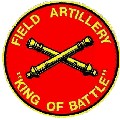 I think it is interesting when historic facts repeat or nearly repeat themselves in a family. It is a fact that Thomas M. Rice was probably killed as a result of artillery fire.
I think it is interesting when historic facts repeat or nearly repeat themselves in a family. It is a fact that Thomas M. Rice was probably killed as a result of artillery fire.
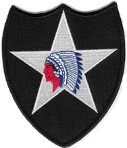 This same thing nearly happened to my father during World War II. Staff Sgt. H. M. Rice was an infantryman with the 2nd Infantry Division fighting the Germans. He had fought at Normandy and Brest, France. While attacking the Siegfried Line in Germany on Dec. 13, 1944, he was in a forest that had snow on the ground. As he was moving forward on the attack a German artillery shell hit a tree in his near vicinity. It was a tree top burst that sent a shower of jagged scrapnel in every direction. One small piece hit him in the back and then the tree fell on top of him. His buddies helped him get on his feet and he walked by himself to the rear where he was hospitalized and eventually sent home to Texas with a lifetime disability.
This same thing nearly happened to my father during World War II. Staff Sgt. H. M. Rice was an infantryman with the 2nd Infantry Division fighting the Germans. He had fought at Normandy and Brest, France. While attacking the Siegfried Line in Germany on Dec. 13, 1944, he was in a forest that had snow on the ground. As he was moving forward on the attack a German artillery shell hit a tree in his near vicinity. It was a tree top burst that sent a shower of jagged scrapnel in every direction. One small piece hit him in the back and then the tree fell on top of him. His buddies helped him get on his feet and he walked by himself to the rear where he was hospitalized and eventually sent home to Texas with a lifetime disability.
 The war diary of Staff Sergeant H.M. Rice (U.S. 2nd Infantry Division, World War 2)
The war diary of Staff Sergeant H.M. Rice (U.S. 2nd Infantry Division, World War 2)
American Lieutenant Colonel Walter William Rice, son of William Henry Rice, saw 3 months duty against Japan during World War II. He was an artillery officer in the 81st Division. He fired the artillery rather than have it "rain down on him." American artillery was so accurate they could hit a bed sheet 5 miles away. When an artillery shell exploded it threw pieces of steel in a circular fashion 3 feet above the ground. That's why infantrymen "hit the dirt" when it started falling around them.
Concerning falling trees, the son of Thomas Rice, Oliver H. Rice, died when a log fell on him while he was helping build a cabin (at a cabin raising event) for one of his Texas neighbors. Oliver H. Rice, Junior, died as a boy when a tree he was cutting down fell over on him crushing him to death.
William Wilson Rice and Thomas R. Rice died of old age but, following the Civil War, James Rice, Thomas' oldest son, was driving a commercial wagon. He was shot off of his wagon by jayhawkers and left dead alongside of the highway. He was buried in an unmarked grave. He left no wife nor children.
Killed In Action
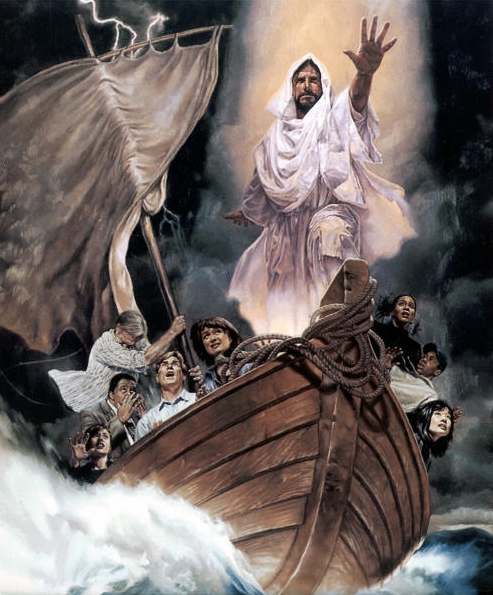 During World War II the U.S. Army would send a telegram to a soldier's next of kin if he died in defense of his nation. Every family was terrified of receiving such a notice as it caused so much pain. The telegram conveyed the message their loved one was "killed in action." That means that he died in battle- that he went out of this life in a blaze of glory. It is a risk that every soldier takes in every war.
During World War II the U.S. Army would send a telegram to a soldier's next of kin if he died in defense of his nation. Every family was terrified of receiving such a notice as it caused so much pain. The telegram conveyed the message their loved one was "killed in action." That means that he died in battle- that he went out of this life in a blaze of glory. It is a risk that every soldier takes in every war.
Thomas M. Rice was killed in action but Elizabeth did not receive such a telegram because she was told in person as the Texas Militia always expressed their personal regrets. What a horrifying time it must have been when the rider dismounted at her house and told her that Captain Dawson and his men had fallen in battle and that her beloved husband, Thomas M. Rice, had been killed in action. How did she feel?
I think I can express her feelings through my mother's similar experience in 1987. My father, H.M. Rice, had had quadruple by-pass open heart surgery 3 years earlier. The doctor used stainless steel wire to wire his sternum (breast bone) back together. He was under doctor's orders not to exhert himself physically nor eat a lot of high cholesterol food. But he violated both of these orders and when he would do push-up exercises on the floor he would laugh at the sound his sternum made as the two halves rubbed together. He had just come from the doctor who told him he was in great shape and that he would live to be 100 years old. He was 64 years old and crowed about how he had outlived his father who died at age 64. Hanford was retired, but became the President of the South Cloverdale (Calif.) Water Company. Since his interest was electricity he went down to the pumping station and rewired electric motors and ran underground electric wires doing the work himself. The company gave him a raise in pay and this
really excited him so he wanted to do more. One morning he grabbed a heavy metal digging bar and went to dig in the ground at a water junction box. While digging he suffered a massive heart attack. He walked 2 steps toward his pick-up truck and sat on the seat reaching for the microphone of his 2 way cb (civilian band) radio. His handle was "Bear Tracks" and he was trying to call mom. He died there on his pick-up seat. The deputy sheriff found him and drove to mom's house with the bad news.
 The deputy sheriff told my mom that her husband was dead. Mom did not shriek, or cry, or wail out loud (like the women of Gonzales, Texas, did in 1836, when they heard the bad news that 33 of their men had been killed at the Alamo). Mom said it was just like somebody had hauled off and punched her in the stomach. She was stunned and emotionally sick and had to go into the house and lay down.
The deputy sheriff told my mom that her husband was dead. Mom did not shriek, or cry, or wail out loud (like the women of Gonzales, Texas, did in 1836, when they heard the bad news that 33 of their men had been killed at the Alamo). Mom said it was just like somebody had hauled off and punched her in the stomach. She was stunned and emotionally sick and had to go into the house and lay down.
I am sure Elizabeth took Tom's death real hard. It must have been a visit for Elizabeth just like the one my mother received. It was not a good time for the Thomas Rice Family in Cuero in 1842. But it is normal for a person to grieve for a year over the death of a loved one.
A Telegram That Never Had To Be Delivered
 Sgt. H.M. Rice was fighting the Germans in the hedgerows of France east of St. Lo during World War II. He ran across one of the hedgerow openings while checking on his men when a German machine gunner opened fire on him. As he was running he tripped over something and fell flat on his face. Just when he did a stream of machine gun bullets ripped directly over him. If he had not fallen he would have been killed. He looked back to see what he had tripped over that saved his life. There was nothing there. That is when he knew that his guardian angel had saved his life. It was a telegram that never had to be delivered. I wondered about this so one day I asked his mother about this. She said that her sons were in the military during World War II (Montrose was in the Navy, and Conard, Hanford, and Davis were in the Army. Two did not go: Hale was crippled with polio and J. Howard was too young). She told me she was in intercessory prayer constantly for her sons who were in the military at that time. She knew it
was Christ who had saved Hanford's life on the battlefield of Normandy. She proudly boasted (and rightly so) that God brought all of her sons back to her from the war.
Sgt. H.M. Rice was fighting the Germans in the hedgerows of France east of St. Lo during World War II. He ran across one of the hedgerow openings while checking on his men when a German machine gunner opened fire on him. As he was running he tripped over something and fell flat on his face. Just when he did a stream of machine gun bullets ripped directly over him. If he had not fallen he would have been killed. He looked back to see what he had tripped over that saved his life. There was nothing there. That is when he knew that his guardian angel had saved his life. It was a telegram that never had to be delivered. I wondered about this so one day I asked his mother about this. She said that her sons were in the military during World War II (Montrose was in the Navy, and Conard, Hanford, and Davis were in the Army. Two did not go: Hale was crippled with polio and J. Howard was too young). She told me she was in intercessory prayer constantly for her sons who were in the military at that time. She knew it
was Christ who had saved Hanford's life on the battlefield of Normandy. She proudly boasted (and rightly so) that God brought all of her sons back to her from the war.

Well done!
Conclusion
Thomas M. Rice died fighting for Texas independence. He made the ultimate sacrifice for his Republic of Texas, his immediate family, and his future descendants. Let him never be forgotten. Let him always be our hero. And lets consider this article written about him to be a salute and a tribute in appreciation to him. It is a 21 gun salute if you please and if we had a silver cup made for him we could enscribe the words "well done" on it. He is indeed our hero of freedom.

I like what was in the Edmund Rice Association newsletter in 1995:
"In the Spring, 1994, issue was an article about Thomas McClure Rice, who emigrated to Texas with his wife and family in 1836, settling near Fort Bend. Thomas McClure answered a call to arms after the battle at the Alamo, and was killed in action on September 18, 1842, at the Battle of Salado Creek, leaving his wife and five children, aged seven months to fifteen years. Life went on for Elizabeth Wilson Rice, who raised her children and lived until 1858.
In May, 1995, a memorial plaque was dedicated by the TMRA in the cemetery where Elizabeth is believed buried. The last paragraph reads, "The sacrifice and legacy of Elizabeth and Thomas Rice will always serve their hundreds of descendants and the people of Texas."

Anita Cooper, President of the TMRA, reported: Dear Edmund Rice Association:
"It is my pleasure to report a most exhilarating inaugural meeting of the THOMAS RICE MCCLURE ASSOCIATION (TMRA) on May 6, 1995. Seventy-one were in attendance at the Clinton Cemetery in Cuero, Texas, for the dedication of the memorial marker for ELIZABETH WILSON RICE. Members of the James W. Fannin Chapter, Victoria, Texas, of the DAUGHTERS OF THE REPUBLIC OF TEXAS conducted the ceremony. The memorial is a 24" x 36" bronze plaque with a CITIZEN OF THE REPUBLIC OF TEXAS medallion at the top. It is a fitting tribute to one who sacrificed so much and gave us the rich heritage of strength and courage.
Also in attendance was the Texas Living History Color Guard. Five members in period constumes made the cermony more meaningful. They have since "adopted" the cemetery, ELIZABETH's marker in particular, as their own.
The TMRA now has 50 charter members. Much enthusiasm is evident with each one. All are willing to make the Association a success. Members came from as far away as Maryland, and from 20 towns and cities in West, South and Central Texas. Fourth to seventh generations were represented....
We are particularly appreciative to Dennis Rice representing the EDMUND RICE ASSOCIATION. His enthusiasm and knowledge helped to foster an even greater appreciation for the goals of both associations. [The number of] new members to your association is evidence of his work here.
We look forward to many years of productive and enjoyable times....
Anita Cooper, President."
The Thomas McClure Rice Association is now inactive but it was wonderful that such an organization once honored his name, memory, and sacrifice.
Let's keep the remembrance of Thomas McClure Rice and his Texas Republic alive. And like the flag over Texas I say, "Long may it endure!"

Click here to go to part one of the history of this family in the U.S.A.
www.7-star-admiral.com

Click on the above picture if you want to learn how to have peace in your heart.





since June 27, 2014



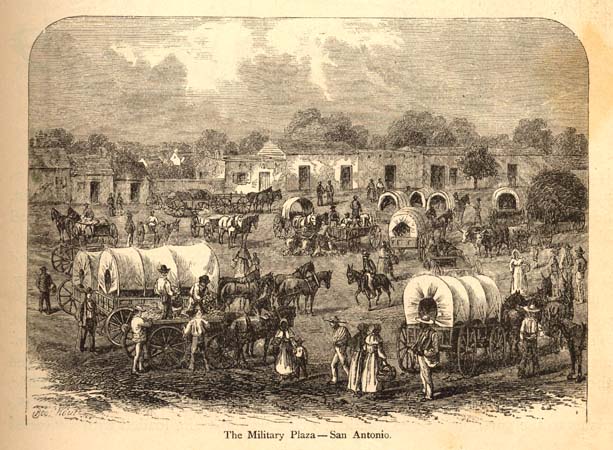

 Thomas Rice received his free land grant in Fort Bend County, Texas, in 1836. There he built a log cabin house for his family to live in, similar to the one his father built in Ohio.
"Well into the 1840's, the homes of Texas farmers were usually rough-and-ready log cabins. As one settler wrote, many houses consisted of one room that "harbored the whole family and comers and goers."
Thomas Rice received his free land grant in Fort Bend County, Texas, in 1836. There he built a log cabin house for his family to live in, similar to the one his father built in Ohio.
"Well into the 1840's, the homes of Texas farmers were usually rough-and-ready log cabins. As one settler wrote, many houses consisted of one room that "harbored the whole family and comers and goers."
 "The small farmer, who raised a few acres of cotton and perhaps a dozen cattle in order to compliment his subsistence crop of corn, still had little money to show for his labors. But every industrious farmer was able to make a decent living; and he could always trade his produce for anything he wanted, from a new plow to fine fabric for the family's Sunday best. Everyone drank coffee- lots of it- and practically everyone used tobacco in some form."
"The small farmer, who raised a few acres of cotton and perhaps a dozen cattle in order to compliment his subsistence crop of corn, still had little money to show for his labors. But every industrious farmer was able to make a decent living; and he could always trade his produce for anything he wanted, from a new plow to fine fabric for the family's Sunday best. Everyone drank coffee- lots of it- and practically everyone used tobacco in some form."

 Money became very scarce in 1837, one year after Tom and Liz moved to Texas. The Panic of 1837 under the Van Buren administration plunged the United States into an economic depression. Texas was not a part of the United States at this time, but this recession also hurt many folk financially in Texas so everyone used the barter system where they traded goods. Most all farmers and cattle ranchers had to grow much of their own food.
Money became very scarce in 1837, one year after Tom and Liz moved to Texas. The Panic of 1837 under the Van Buren administration plunged the United States into an economic depression. Texas was not a part of the United States at this time, but this recession also hurt many folk financially in Texas so everyone used the barter system where they traded goods. Most all farmers and cattle ranchers had to grow much of their own food.
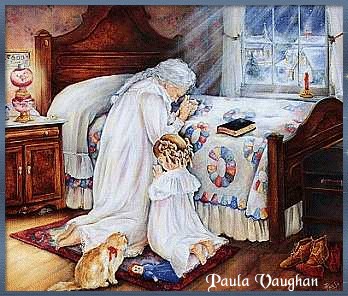
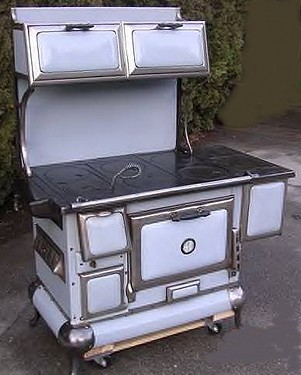
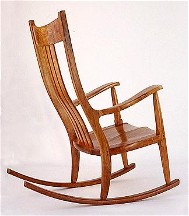




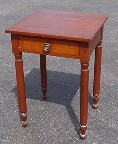
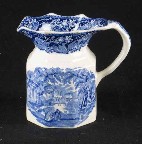
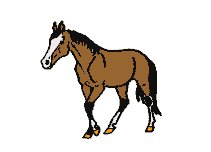


 A big hurricane leveled Galveston, Texas in the fall of 1837. With high velocity winds and torrential rain it hit all on the Texas plain. Tom and Liz's house got rain soaked- everything that they had brought with them from Ohio got wet. I imagine that this tragedy triggered a remembrance for him back to the days in Ohio when he was a boy of the earthquake that shook his home apart. Many people got flooded and swept away in the flood waters that fall when the rivers over flowed their banks. But no loss of life happened to Tom and his family. Everything they had (that had gotten wet) had to be dried off and made useable again. It was just one setback they overcame besides the financial depression- but the biggest setback was still ahead of them- and it would happen to them during the war.
A big hurricane leveled Galveston, Texas in the fall of 1837. With high velocity winds and torrential rain it hit all on the Texas plain. Tom and Liz's house got rain soaked- everything that they had brought with them from Ohio got wet. I imagine that this tragedy triggered a remembrance for him back to the days in Ohio when he was a boy of the earthquake that shook his home apart. Many people got flooded and swept away in the flood waters that fall when the rivers over flowed their banks. But no loss of life happened to Tom and his family. Everything they had (that had gotten wet) had to be dried off and made useable again. It was just one setback they overcame besides the financial depression- but the biggest setback was still ahead of them- and it would happen to them during the war.
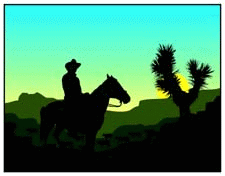 The movements of the Thomas McClure Rice family are not hard to trace. They received their land grant in Fort Bend County, Texas, in 1836. Thomas Rice is listed in the June 1840 census of Texas as living in Fort Bend County. They were still poor, owning only one saddle horse. His job was being a cowboy so he needed this horse. 13 months later his name appears in the Texas Sentinel Newspaper for being delinquent in the payment of his property taxes in Fort Bend County in the amount of $1.25. However, in the fall of 1841 they moved to the Cuero area (Gonzales County at that time but present-day De Witt County). I have been to this area and it resembles greatly the area he came from in Ohio so it must have seemed familiar to him. We know when he moved because his youngest son, Thomas Richard Rice, was born in Cuero in February of 1842, but they maintained ownership of their land in Fort Bend County for awhile.
The movements of the Thomas McClure Rice family are not hard to trace. They received their land grant in Fort Bend County, Texas, in 1836. Thomas Rice is listed in the June 1840 census of Texas as living in Fort Bend County. They were still poor, owning only one saddle horse. His job was being a cowboy so he needed this horse. 13 months later his name appears in the Texas Sentinel Newspaper for being delinquent in the payment of his property taxes in Fort Bend County in the amount of $1.25. However, in the fall of 1841 they moved to the Cuero area (Gonzales County at that time but present-day De Witt County). I have been to this area and it resembles greatly the area he came from in Ohio so it must have seemed familiar to him. We know when he moved because his youngest son, Thomas Richard Rice, was born in Cuero in February of 1842, but they maintained ownership of their land in Fort Bend County for awhile.


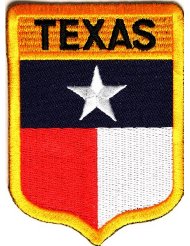 "Texas had only been a Republic for 6 years, and during the spring and summer of 1842, a great interest was felt throughout the Republic for the annexation of Texas to the United States, but Mexico hated the idea that Texas might become a part of the United States.
"Texas had only been a Republic for 6 years, and during the spring and summer of 1842, a great interest was felt throughout the Republic for the annexation of Texas to the United States, but Mexico hated the idea that Texas might become a part of the United States.
 "However, Mirabeau Lamar had succeeded at last in arousing Mexico, and Houston inherited the minor whirlwind the Buonaparte of Texas had stirred up. Santa Anna had bided his time and was again President of Mexico. Fired by the belief that Mexico, to keep any international belief in its sovereignty over Texas and to prevent further raids like the one on Santa Fe (trying to grab land), had to do something, Santa Anna sent an expedition north across the Rio Grande, in the spring of 1842. This was not an attempt to reconquer Texas; it was a show of force. The Mexican army easily captured San Antonio, Refugio, and Goliad- this time unopposed. Mexican Gen. Rafael Vasquez did nothing, however, but occupy the cities, raise the Mexican flag, inspect Texan defenses, and withdraw."
"However, Mirabeau Lamar had succeeded at last in arousing Mexico, and Houston inherited the minor whirlwind the Buonaparte of Texas had stirred up. Santa Anna had bided his time and was again President of Mexico. Fired by the belief that Mexico, to keep any international belief in its sovereignty over Texas and to prevent further raids like the one on Santa Fe (trying to grab land), had to do something, Santa Anna sent an expedition north across the Rio Grande, in the spring of 1842. This was not an attempt to reconquer Texas; it was a show of force. The Mexican army easily captured San Antonio, Refugio, and Goliad- this time unopposed. Mexican Gen. Rafael Vasquez did nothing, however, but occupy the cities, raise the Mexican flag, inspect Texan defenses, and withdraw."
 Texas president Houston ordered Colonel Mathew Caldwell of the Texas Army at Gonzales, Texas, to gather together the Texas minutemen and militia to attack Gen. Woll at San Antonio. Caldwell gathered a militia of 225 men at the Cibolo River on the San Antonio Road above Seguin and marched toward San Antonio. Some of these troops included former prisoners involved in the unsuccessful Santa Fe expedition including Colonel Mathew Caldwell. On September 17, his troops made camp about 6 miles east of San Antonio below present New Braunfels at Salado Creek and planned their attack on the Mexicans.
Texas president Houston ordered Colonel Mathew Caldwell of the Texas Army at Gonzales, Texas, to gather together the Texas minutemen and militia to attack Gen. Woll at San Antonio. Caldwell gathered a militia of 225 men at the Cibolo River on the San Antonio Road above Seguin and marched toward San Antonio. Some of these troops included former prisoners involved in the unsuccessful Santa Fe expedition including Colonel Mathew Caldwell. On September 17, his troops made camp about 6 miles east of San Antonio below present New Braunfels at Salado Creek and planned their attack on the Mexicans.
 The Mexican Army attacked across open ground in front of Caldwell's men. They were cut to pieces. The front lines of the Mexican infantry were forced to fall back behind their cannons for cover, out of rifle range. They made several smaller charges that were repulsed with heavy casualties.
The Mexican Army attacked across open ground in front of Caldwell's men. They were cut to pieces. The front lines of the Mexican infantry were forced to fall back behind their cannons for cover, out of rifle range. They made several smaller charges that were repulsed with heavy casualties.





 "Passing Waelder, they were overtaken by two current Lavaca County residents, John Cummings and W.D. Patterson. Residents from the area, now DeWitt County, Thomas J. Butler, Elijah Garey, Thomas Rice and William Savage caught up with the group near the same area. On down the Seguin Road, the Negro slave of Samuel A. Maverick, Joe Griffin, caught up with the group. He was heavily armed and carrying a ransom sent by Mrs. Maverick for release of her husband. Somewhere near Nash's Creek about 15 miles west of Gonzales, Alsey Miller joined the group from the company of Capt. Jesse Billingsley which was still forming for the trip to San Antonio. Capt. Dawson could not be persuaded to wait for Capt. Billingsley who suggested that they march to San Antonio together. A Mr. Adams, Charles Fields, Thompson D. James, Asa Jones, John Jones, William Linn and John McCrady joined the Dawson group somewhere on the journey. At camp near Nash's Creek, Capt. Dawson was elected Captain and Dickerson Lieutenant."
"Passing Waelder, they were overtaken by two current Lavaca County residents, John Cummings and W.D. Patterson. Residents from the area, now DeWitt County, Thomas J. Butler, Elijah Garey, Thomas Rice and William Savage caught up with the group near the same area. On down the Seguin Road, the Negro slave of Samuel A. Maverick, Joe Griffin, caught up with the group. He was heavily armed and carrying a ransom sent by Mrs. Maverick for release of her husband. Somewhere near Nash's Creek about 15 miles west of Gonzales, Alsey Miller joined the group from the company of Capt. Jesse Billingsley which was still forming for the trip to San Antonio. Capt. Dawson could not be persuaded to wait for Capt. Billingsley who suggested that they march to San Antonio together. A Mr. Adams, Charles Fields, Thompson D. James, Asa Jones, John Jones, William Linn and John McCrady joined the Dawson group somewhere on the journey. At camp near Nash's Creek, Capt. Dawson was elected Captain and Dickerson Lieutenant."
 Captain Dawson was in a desperate way. He had approximately 26 men killed (half of his outfit), his means of escape was cut off, and he had no help coming from any quarter. Since his situation was hopeless, he decided to surrender. For an enemy leader to fall into Mexican hands meant almost certain death.
"Dawson sent out a white flag, but it was fired on," says the Yoakum account. A short time later Dawson emerged from the thicket with a blanket on his rifle in an attempt to call a cease-fire, but in the confusion some of his men took no notice and continued firing." In the fog of war, both sides continued to fire and Dawson was killed. The battle was over after a little more than one hour. Then a cavalry charge was made by the enemy into the grove against the Texians.
Captain Dawson was in a desperate way. He had approximately 26 men killed (half of his outfit), his means of escape was cut off, and he had no help coming from any quarter. Since his situation was hopeless, he decided to surrender. For an enemy leader to fall into Mexican hands meant almost certain death.
"Dawson sent out a white flag, but it was fired on," says the Yoakum account. A short time later Dawson emerged from the thicket with a blanket on his rifle in an attempt to call a cease-fire, but in the confusion some of his men took no notice and continued firing." In the fog of war, both sides continued to fire and Dawson was killed. The battle was over after a little more than one hour. Then a cavalry charge was made by the enemy into the grove against the Texians.
 Thomas Rice killed in the Texas Dawson Expedition
Thomas Rice killed in the Texas Dawson Expedition

 During the 1936 Texas Centennial Year, $10,000 was provided for the erection of a suitable memorial to those Texas martyrs in the cause of liberty. An imposing granite vault was erected to enclose the original tomb which had deteriorated. The Dawson marker was unveiled near the Salado Battlefield with appropriate ceremonies on the 93rd anniversary of the battle, Sept. 18, 1935." The grave site is now part of the Kreische Brewery State Historic Site.
During the 1936 Texas Centennial Year, $10,000 was provided for the erection of a suitable memorial to those Texas martyrs in the cause of liberty. An imposing granite vault was erected to enclose the original tomb which had deteriorated. The Dawson marker was unveiled near the Salado Battlefield with appropriate ceremonies on the 93rd anniversary of the battle, Sept. 18, 1935." The grave site is now part of the Kreische Brewery State Historic Site.
 Some More Information on the Dawson Expedition
Some More Information on the Dawson Expedition

 "The war appears to have fairly set in. A dispatch dated Camp Salado 20th September mentions that Colonel Caldwell, with a force of 350 men had an engagement with General Woll, in which the Texians came off victorious. The Mexicans left 100 killed on the field of battle, besides 200 wounded. We regret to say that a company of 59 men, called the Fayette volunteers, in attempting to join the camp of Col. Caldwell, were cut off and took position in a thicket, from which they defended themselves against an infinitely superior force until completely cut to pieces; 33 of the number were found dead on the field, and the remainder supposed to have been made prisoners of war."
"The war appears to have fairly set in. A dispatch dated Camp Salado 20th September mentions that Colonel Caldwell, with a force of 350 men had an engagement with General Woll, in which the Texians came off victorious. The Mexicans left 100 killed on the field of battle, besides 200 wounded. We regret to say that a company of 59 men, called the Fayette volunteers, in attempting to join the camp of Col. Caldwell, were cut off and took position in a thicket, from which they defended themselves against an infinitely superior force until completely cut to pieces; 33 of the number were found dead on the field, and the remainder supposed to have been made prisoners of war."
 Elizabeth Carries On in Texas
Elizabeth Carries On in Texas
 What's In a Name?
What's In a Name?
 Elizabeth attended Martha's wedding to Joseph A. Newman in Wharton Co., Texas, on Feb. 9, 1848, and it was a joyous day for all of them. For awhile Joseph accepted Asa as his own son and Asa is listed as Asa Newman on the 1850 census. Once again Elizabeth got to attend the birth of another one of her grandsons when Martha gave birth to her second son, Leander G. Newman born in 1849. But it was a sad day when Elizabeth had to attend the funeral of Martha a few years later. Asa was then raised by grandma Elizabeth and also he spent a lot of time working on Oliver's farm. Asa loved his two favorite uncles: Oliver and James because Asa named his first son after them, Oliver James Rice. Asa took his mother's maiden name of Rice for his last name due to their kind and loving influence on him.
Elizabeth attended Martha's wedding to Joseph A. Newman in Wharton Co., Texas, on Feb. 9, 1848, and it was a joyous day for all of them. For awhile Joseph accepted Asa as his own son and Asa is listed as Asa Newman on the 1850 census. Once again Elizabeth got to attend the birth of another one of her grandsons when Martha gave birth to her second son, Leander G. Newman born in 1849. But it was a sad day when Elizabeth had to attend the funeral of Martha a few years later. Asa was then raised by grandma Elizabeth and also he spent a lot of time working on Oliver's farm. Asa loved his two favorite uncles: Oliver and James because Asa named his first son after them, Oliver James Rice. Asa took his mother's maiden name of Rice for his last name due to their kind and loving influence on him.
 Elizabeth attended the wedding of her son, Oliver Rice, when he wed Adeline Courtney at Clinton, Texas, on March 22, 1854. It was a happy day for all. She was there when her grandson was born in 1855. In regards to Oren A. Rice- there has been quite a discussion on what his name really was. In several census accounts it is listed as Orien, Aaron, and Oren. I think it could have been O'Ryan, possibly one of Elizabeth's ancestors from Ireland. Nevertheless, the name was settled by the man himself and he called himself Oren. The relatives called him "Uncle Iron." And Elizabeth was blessed with another grandson from Oliver and Adeline, William Henry Rice.
Elizabeth attended the wedding of her son, Oliver Rice, when he wed Adeline Courtney at Clinton, Texas, on March 22, 1854. It was a happy day for all. She was there when her grandson was born in 1855. In regards to Oren A. Rice- there has been quite a discussion on what his name really was. In several census accounts it is listed as Orien, Aaron, and Oren. I think it could have been O'Ryan, possibly one of Elizabeth's ancestors from Ireland. Nevertheless, the name was settled by the man himself and he called himself Oren. The relatives called him "Uncle Iron." And Elizabeth was blessed with another grandson from Oliver and Adeline, William Henry Rice.


 I think it is interesting when historic facts repeat or nearly repeat themselves in a family. It is a fact that Thomas M. Rice was probably killed as a result of artillery fire.
I think it is interesting when historic facts repeat or nearly repeat themselves in a family. It is a fact that Thomas M. Rice was probably killed as a result of artillery fire.
 This same thing nearly happened to my father during World War II. Staff Sgt. H. M. Rice was an infantryman with the 2nd Infantry Division fighting the Germans. He had fought at Normandy and Brest, France. While attacking the Siegfried Line in Germany on Dec. 13, 1944, he was in a forest that had snow on the ground. As he was moving forward on the attack a German artillery shell hit a tree in his near vicinity. It was a tree top burst that sent a shower of jagged scrapnel in every direction. One small piece hit him in the back and then the tree fell on top of him. His buddies helped him get on his feet and he walked by himself to the rear where he was hospitalized and eventually sent home to Texas with a lifetime disability.
This same thing nearly happened to my father during World War II. Staff Sgt. H. M. Rice was an infantryman with the 2nd Infantry Division fighting the Germans. He had fought at Normandy and Brest, France. While attacking the Siegfried Line in Germany on Dec. 13, 1944, he was in a forest that had snow on the ground. As he was moving forward on the attack a German artillery shell hit a tree in his near vicinity. It was a tree top burst that sent a shower of jagged scrapnel in every direction. One small piece hit him in the back and then the tree fell on top of him. His buddies helped him get on his feet and he walked by himself to the rear where he was hospitalized and eventually sent home to Texas with a lifetime disability.
 During World War II the U.S. Army would send a telegram to a soldier's next of kin if he died in defense of his nation. Every family was terrified of receiving such a notice as it caused so much pain. The telegram conveyed the message their loved one was "killed in action." That means that he died in battle- that he went out of this life in a blaze of glory. It is a risk that every soldier takes in every war.
During World War II the U.S. Army would send a telegram to a soldier's next of kin if he died in defense of his nation. Every family was terrified of receiving such a notice as it caused so much pain. The telegram conveyed the message their loved one was "killed in action." That means that he died in battle- that he went out of this life in a blaze of glory. It is a risk that every soldier takes in every war.
 The deputy sheriff told my mom that her husband was dead. Mom did not shriek, or cry, or wail out loud (like the women of Gonzales, Texas, did in 1836, when they heard the bad news that 33 of their men had been killed at the Alamo). Mom said it was just like somebody had hauled off and punched her in the stomach. She was stunned and emotionally sick and had to go into the house and lay down.
The deputy sheriff told my mom that her husband was dead. Mom did not shriek, or cry, or wail out loud (like the women of Gonzales, Texas, did in 1836, when they heard the bad news that 33 of their men had been killed at the Alamo). Mom said it was just like somebody had hauled off and punched her in the stomach. She was stunned and emotionally sick and had to go into the house and lay down.
 Sgt. H.M. Rice was fighting the Germans in the hedgerows of France east of St. Lo during World War II. He ran across one of the hedgerow openings while checking on his men when a German machine gunner opened fire on him. As he was running he tripped over something and fell flat on his face. Just when he did a stream of machine gun bullets ripped directly over him. If he had not fallen he would have been killed. He looked back to see what he had tripped over that saved his life. There was nothing there. That is when he knew that his guardian angel had saved his life. It was a telegram that never had to be delivered. I wondered about this so one day I asked his mother about this. She said that her sons were in the military during World War II (Montrose was in the Navy, and Conard, Hanford, and Davis were in the Army. Two did not go: Hale was crippled with polio and J. Howard was too young). She told me she was in intercessory prayer constantly for her sons who were in the military at that time. She knew it
was Christ who had saved Hanford's life on the battlefield of Normandy. She proudly boasted (and rightly so) that God brought all of her sons back to her from the war.
Sgt. H.M. Rice was fighting the Germans in the hedgerows of France east of St. Lo during World War II. He ran across one of the hedgerow openings while checking on his men when a German machine gunner opened fire on him. As he was running he tripped over something and fell flat on his face. Just when he did a stream of machine gun bullets ripped directly over him. If he had not fallen he would have been killed. He looked back to see what he had tripped over that saved his life. There was nothing there. That is when he knew that his guardian angel had saved his life. It was a telegram that never had to be delivered. I wondered about this so one day I asked his mother about this. She said that her sons were in the military during World War II (Montrose was in the Navy, and Conard, Hanford, and Davis were in the Army. Two did not go: Hale was crippled with polio and J. Howard was too young). She told me she was in intercessory prayer constantly for her sons who were in the military at that time. She knew it
was Christ who had saved Hanford's life on the battlefield of Normandy. She proudly boasted (and rightly so) that God brought all of her sons back to her from the war.






